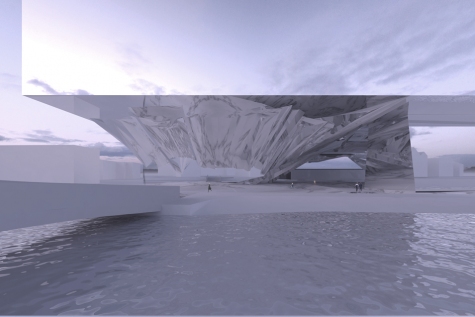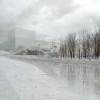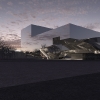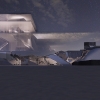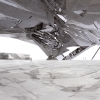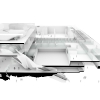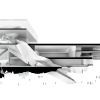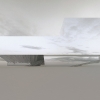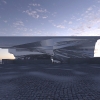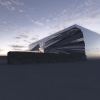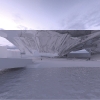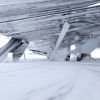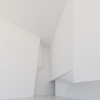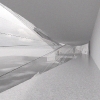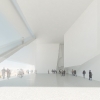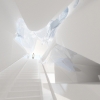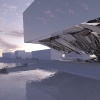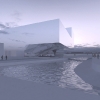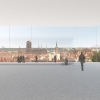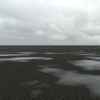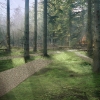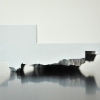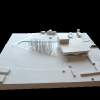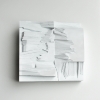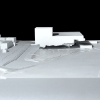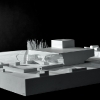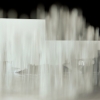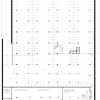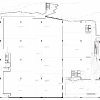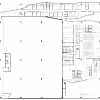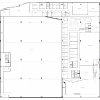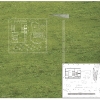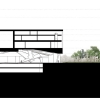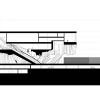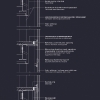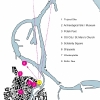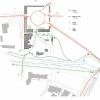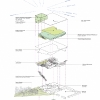Museum of the Second World War International Competition
Project Description
In human experience there is no greater contrast than the conditions of peace and war.
The architecture of the museum building and its landscapes posits the conditions of contrast that invoke contemplation of the contradictions that war overlays onto human endeavor. Ultimately, the magnification and illumination of the museum’s message is the project of the architecture and the landscape.
The Primordial Forest
The museum landscape is suspended between a calm refuge and a tumultuous history—an archetype of the symbolic Polish forest transported to Gdansk. Like the landscape Adam Mickiewicz describes in “Pan Taduesz,” the Polish forest has been a refuge maintaining the continuity of Polish identity in times of political turmoil. Monumental trees symbolize the fatherland, and ancientness is felt everywhere.
“Ye forests! The last to hunt among you there / Was the last king Witold’s cap to wear, / Last happy warrior of
Jagiello’s race, / Last Lithuanian monarch of the chase. / Trees of my fatherland! If heaven will / That I return
there, shall I find you still? / My friends of old, are you alive today? / Among whom as a child I used to play…”
Like the ancient splintered trunks of Białowieża Forest, fractured paths weave through the museum landscape. Moving from the museum toward thick woodland and clearings, the paths lead each visitor on their own course of reflection and discovery, coming upon outdoor exhibits suddenly in small clearings, as if upon the lost and found traces of the Great War in the old forest.
The dense woodland and under-building entry plaza create a relative dichotomy between enclosure and expanse: woodland trees as a vertical advisor from ground to sky and hovering architectural form as continuous guide to the horizon beyond. The forest raises awareness and questions of origins and beginnings, while the building seeks a new point of view. The auto plaza completes the triptych of contrasting environments: un-engineered, non-mediated, expansive openness requiring a social pact of civilized behavior.
The Museum Building
The museum building questions the fine line between monument and building, between meaning and use and between the beautiful and the unthinkable. Each successive component of the museum layers the pragmatic with an evocative spatial experience, reorienting the visitor toward a new perspective, a way of entering into the subject of the war and the city of Gdansk.
The architectural form of the museum, overhead at the entry plaza (Level +0m), sharp, jagged, thrusting, both reflects and draws in the image of the individual into the chaotic array. The sheer magnitude of the entry plaza alludes to the enormity of World War II while its definitive edges and the horizon beyond signal the finite aspect of war and the hope of the future.
From the plaza, the sequence of the entry zone complex is organized vertically. The ascending event of the escalator from Level +0m to Level +25m architecturally moves from chaos and question to the progressively calmer, more orderly and reassuring environment of the Museum Entry Hall / Urban Observatory. There the story of Gdansk begins to unfold with an overview of the city and its position on the Baltic Sea relative to Westerplatte. Important points of interest from the Urban Observatory include Old Town, the Polish Post, the Solidarity Monument, the Baltic Sea, the Shipyards, the Motława River and the Radunia Canal, the Castle Archeological Site, patterns of ancient city fortifications and the general fabric of greater Gdansk.
The Urban Observatory constitutes the “feature,” that portion of the museum that rises above the +25m elevation. Always open to the public, the Urban Observatory is a gift to the people of Gdansk, a place of privileged views and pride of history. It is a beacon in the evening sky over Gdansk.
At Level +25m, tickets and information are available. Just above at Level +34m, the cinema complements the experience of Level +25m by further introducing the visitor to World War II and Gdansk. Varied presentations at the cinema draw locals to the museum for repeat visits as does the restaurant.
Visitors now descend to Level +11m to the Exhibition Entry Hall, also always open to the public. Along the descent, eyes have time to adjust somewhat and be ready for the exhibitions, either permanent or temporary or both. In conjunction with the exhibitions, public amenities including the cloak room, public toilets, the children’s area and the Conference Hall Complex are located on Level +16.8m and are accessed by a monumental stair or elevator. Within the permanent exhibition, rest areas are organized, for the most part, so that daylight and views out offer relief from the intensity of the subject matter.
After the exhibitions, visitors travel along the “forest corridor,” past the museum store and exit the museum by escalator down to Level +0m and the entry plaza, at the point where they first entered the museum. At Level +0m,
the café housed in the southeast corner of the auto plaza wall, looks into the forest, the entry plaza and the main public stair up from parking below. On the west side of the building, the service drive and loading dock are accessed to the north by Wałowa Street and to the south by Więcierze Street, hidden from the entry plaza. Freight elevators connect the loading dock area to Level -3.8m and Level -7.8m where the technical service and storage complexes are located and to exhibitions at Level +11m and a catwalk system at the upper reaches of the permanent exhibition. Natural light is let into the lower levels by a light well around which the occupied spaces are situated. Above the light well at Level +7m is the hotel which overlooks the forest, the Radunia Canal and the entry plaza. The hotel is accessed via stair or elevator in the southeast portion of the entry plaza. The “forest corridor” also leads to the elevator lobby for the administration, the membership club, the library complex and the education complex located on Levels +16.8m and +19.6m.
On Level +16.8m the membership club, a double-height space, overlooks the forest to the east and the auto plaza, shipyards and Baltic Sea to the north. Adjacent to the administration and office complex, specifically the director’s study, the membership club is accessible independent of the administrative function for events that occur after hours or on holidays. The administration suite overlooks the auto plaza and beyond to the Baltic Sea. The adjacency of the administration and office complex and the conference hall complex affords opportunities for cross programming and expanded usage of the two groups of facilities.
On Level +20.9m the educational complex occupies the north wing overlooking the auto plaza, while the library complex occupies the east wing overlooking the forest and the upper zone of the conference hall below. Both are accessed from the elevator lobby in the northeast corner of the building. The pairing of these two complexes implies the possibility for shared resources and programs.
